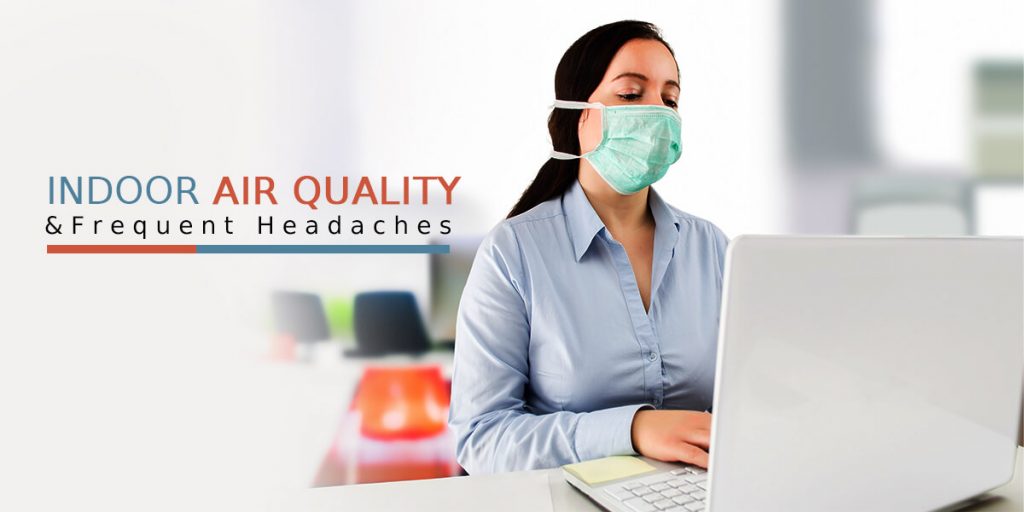The Relation Between Indoor Air Quality and Frequent Headaches
Migraine is not just a headache that goes away with a dose of pain killer. Severe migraines test the patience level of the sufferers. The symptoms of migraines are not just severe headaches but also sickness, skin sensitivity, and problems with balance, vision, and speech. Chronic migraines impair both work and social life. A lot of people are, however, unaware of the fact that indoor air quality also leads to migraines and severe headaches. As you spend 90% of your time indoors, the quality of indoor air has a higher impact on your health. If you too are suffering from frequent bouts of migraines, this blog is for you. Read on to find out the relation between air quality and frequent headaches.
How does Air Pollution Lead to Migraines?
A study found that there is a correlation between migraines, headaches, and air pollution. The pollutants such as Lead, Sulfur Dioxide (SO2), Carbon Monoxide (CO), Nitrogen Dioxide (NO2), and Particulate Matter (PM 10 and PM 2.5) lead to severe migraine and headaches. In fact, it has been found that people with chronic migraine and asthma are sensitive to both NO2 and particulate matter. The presence of these pollutants in the indoor air increases the duration and frequency of headaches.
Which Pollutants are Migraine Sufferers Sensitive to?
The air you breathe contains a lot of contaminants that you may not know. The cleaning materials, cigarette smoke, cosmetics, and perfumes trigger a migraine headache. Cigarettes, for instance, contain nicotine-a vasoactive substance, which changes the size of blood vessels. As the blood vessels are narrow, less blood can reach the tissues that surround your brain. Cigarette smoke irritates your nose or throat, thereby triggering allergic reactions and headaches.
How to Minimize Indoor Air Pollution?
Severe migraines can make it almost impossible for you to work. This is the reason why you need to look out for ways to minimize indoor air pollution. Some of the ways to reduce indoor air pollution are:
1. Use an Air Purifier
One of the most effective ways to reduce indoor air pollution is by installing an air purifier. HEPA air purifiers catch and trap indoor air pollutants from your home so that you breathe safely. The HEPA filters can easily catch and trap pollutants that are as small as 0.3 microns. In addition, the air purifiers are also ideal for removing dust mites, pet hair, and dander from different surfaces and also remove odor and foul smell from the indoor air.
2. Control the Sources of Pollution
Another effective way to improve indoor air quality is by controlling the sources of indoor air pollution. Improve the ventilation of your home to reduce pollutants inside your home. Whenever weather permits, open the door and windows or switch on the air conditioner with the vent control open. If you have exhaust fans in the kitchen or bathroom, turn them on to ventilate your home.
3. Ban Smoking
To minimize and control indoor air pollution, one effective measure is to implement a ban on smoking. By prohibiting smoking indoors, you can significantly reduce the release of harmful pollutants into the air. Cigarette smoke contains numerous toxic substances, including carbon monoxide and fine particulate matter, which can have detrimental effects on both human health and indoor air quality. By enforcing a ban on smoking, you create a healthier and cleaner environment for everyone within the indoor space, reducing the risks associated with secondhand smoke and improving overall air quality.
4. Give Your Pets a Bath
Minimizing and controlling indoor air pollution can be achieved through a simple practice: giving your pets a bath regularly. Pets, especially those with fur or feathers, can carry allergens, dander, and dust particles that contribute to indoor air pollution. By maintaining a routine of bathing your pets, you can effectively reduce the amount of these airborne pollutants. Regular baths help to remove loose hair, dirt, and allergens from your pets’ coats, preventing them from being released into the indoor environment. This practice can significantly improve indoor air quality, especially for individuals with allergies or respiratory sensitivities. Additionally, it promotes the overall cleanliness and hygiene of your home, creating a healthier and more comfortable living space for both you and your pets.
5. Open Windows
While it may seem counterintuitive, opening windows can actually help minimize and control indoor air pollution. Indoor air can become stagnant and accumulate pollutants over time, including volatile organic compounds (VOCs) from cleaning products, off-gassing from furniture, and indoor allergens. By opening windows, you can promote air circulation and allow fresh outdoor air to enter, diluting and flushing out indoor pollutants. However, it’s important to consider outdoor air quality before opening windows, especially in areas with high outdoor pollution. Using window screens can also prevent the entry of outdoor allergens. Regularly ventilating your indoor spaces can improve air quality and create a healthier environment.
6. Use Exhaust Fans
To minimize and control indoor air pollution, one effective strategy is to utilize exhaust fans in your home. Exhaust fans, such as those installed in kitchens and bathrooms, help to remove pollutants and improve ventilation. When cooking, using an exhaust fan can prevent the accumulation of cooking fumes, smoke, and airborne particles. Similarly, using an exhaust fan in the bathroom helps to eliminate moisture, odors, and potentially harmful contaminants. By expelling pollutants and improving airflow, exhaust fans play a crucial role in maintaining good indoor air quality. Regular use of these fans can help minimize the concentration of pollutants and create a healthier living environment.
Last Few Words
Indoor air pollution can lead to a number of health problems, including severe migraines and headaches. This is the reason why you need to take the right steps to improve indoor air quality. Installing an air purifier is an ideal way to remove harmful pollutants and make your home safe and pollutant-free. To find out more about KENT air purifiers.





